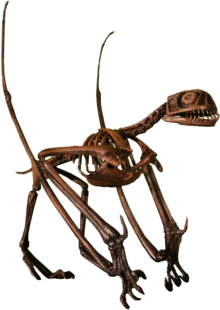Jeholopterus
| Jeholopterus | |
|---|---|

| |
| Skeletal reconstruction in the Rocky Mountain Dinosaur Resource Center, Woodland Park, Colorado | |
| Scientific classification | |
| Domain: | Eukaryota |
| Kingdom: | Animalia |
| Phylum: | Chordata |
| Order: | †Pterosauria |
| Family: | †Anurognathidae |
| Genus: | †Jeholopterus Wang et al., 2002 |
| Type species | |
| †Jeholopterus ningchengensis Wang et al., 2002
| |
Jeholopterus was a small
Naming
The genus was named in 2002 by Wang Xiaolin, Zhou Zhonghe and Xu Xing. The type species, the only known, is Jeholopterus ningchengensis. The genus name is derived from its place of discovery, Jehol in China, and a Latinized Greek pteron, "wing". The specific name refers to Ningcheng County.
Description

The type species is based on
As an anurognathid, Jeholopterus shows the skull form typical for this group, being wider than it was long, at 28 millimeters (1.1 in), with a very broad mouth. Most teeth are small and peg-like, but some are longer and recurved. The neck was short with seven or eight cervical vertebrae. Twelve or thirteen dorsal vertebrae are present and three sacrals. There are five pairs of belly ribs. The tail vertebrae have not been preserved. The describers argue that Jeholopterus had a short tail, a feature seen in other anurognathids but unusual for "
The wing bones are robust. The
The legs are short but robust. The toes bear well-developed curved claws, but these are not as long as the hand claws. The fifth toe is elongated, according to the authors supporting a membrane between the legs, the
Another articulated specimen was discovered no later than 2009 in the Early Cretaceous Sinuiju Formation of North Korea and it represents the first Cretaceous record of Jeholopterus;[6] the specimen was assigned to Jeholopterus cf. ningchengensis by So et al. (2024).[3]
Phylogeny
Jeholopterus was by the authors assigned to the
| Anurognathidae |
| ||||||||||||||||||||||||||||||||||||||||||
Lifestyle
Anurognathids are normally considered insectivores. Wang et al hypothesized that Jeholopterus, being the largest species known of the group, might also have been a piscivore, a fish-eater.[2]
See also
References
- ^ PMID 22411790.
- ^ a b c Wang, X., Zhou, Z., Zhang, F., and Xu, X. (2002). "A nearly completely articulated rhamphorhynchoid pterosaur with exceptionally well-preserved wing membranes and 'hairs' from Inner Mongolia, northeast China." Chinese Science Bulletin 47(3), 226 – 232.
- ^ .
- ^
- ^ Dalla Vecchia, F.M. (2002). "Observations on the non-pterodactyloid pterosaur Jeholopterus ningchengensis from the Early Cretaceous of Northeastern China." Natura Nascosta, 24: 8 - 27.
- ISSN 1225-0929.
- PMID 33850665.
